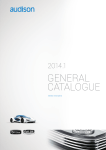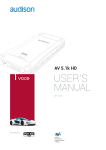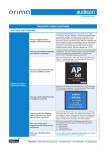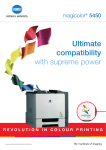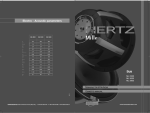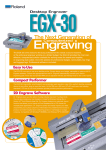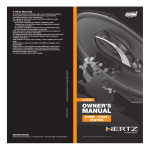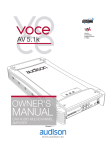Download bit Ten
Transcript
Press information Elettromedia - April 2011 www.audison.eu Press information Elettromedia - April 2011 Connect, Customize, Control 04 Technologies 06 Architecture 08 bit Ten D 10 bit Ten 12 bit one 14 Accessories 16 Glossary 18 About us 19 Press kit to download 20 Visit www.audison.eu in order to find more information. Connect, Customize, Control « A fantastic piece of technology » (Performance Auto & Sound, Canada) « Il fuoriclasse » How many times have we met the limits of OEM or after market integration, expandability or the overall sound quality of our mobile audio system upgrades? Audison bit is the solution: multi-function digital processors capable of interfacing with any analog and/or digital source, transforming ordinary “audio” into a high-performance integrated system. In 2009 Audison introduces bit one, the first Signal Interface Processor conceived and built following the Audison philosophy: to satisfy a genuine passion for Sound, even with based on an OEM source. Quickly, the bit one became a world-wide reference amongst audio processors. The experience that our team acquired allowed us to expand our family of processors, making available the possibility of realizing higher performance systems to a wider audience. bit Ten originates directly from its predecessor, the bit one for signal management, basic functions and PC software. The bit Ten D version can also manage a digital input signal from the head unit, outputting a digital signal to an amplifier(s) featuring AD Link connection. All bit processors feature a powerful DSP (Digital Signal Processor) managed by a simple and intuitive computer software, which ensures a wide array of adjustments to improve the signal through each phase of its path; from input to output. A revolutionary technology; making your dream for acoustic perfection in your vehicle a reality! (ACS, Italy) 04 Connect Connectivity without limits Acoustic reproduction begins with traditional sources such as radio, then Compact Disc and now moving on to the use of new devices like MP3 players, streaming mobile phones and other multimedia devices. The bit processors provide the ability to take advantage of these technologies by bringing them all together, making the most of the musical performance. Input channels for different signal typologies, along with analog and digital output channels ensure vast expandability of any audio system. Customize Listening Freedom The bit project was born with the aim of creating a perfect acoustical environment in every vehicle, customizable for every listening position, letting you experience true mobile bliss. Today’s new vehicles are equipped with audio systems which offer very little, if any, upgrade opportunities. The most technologically advanced factory systems feature proprietary functions that are in most cases essential to the vehicle operation, but their sound is generally unsatisfactory. The bit processors are designed and developed to control every parameter of the reproduction, providing the ability to regenerate and customize the system’s sound to reproduce even the finest details. The concept of complete listening freedom becomes real. Control The digital domain The unlimited calculation capability of the bit processors DSP (Digital Signal Processor) is combined with an extremely user-friendly interface. Specifically designed for audio applications, the DSP processes the signal in the digital domain: the management and control of the acoustic reproduction are further improved by the accuracy and configurability of the digital system. 05 bit Ten & bit Ten D - Technology Signal processing bit Ten features a 32 bit, 147 MHz clock speed Cirrus Logic DSP. It is a special DSP, ensuring high integration, where the main processing functions are implemented in optimized and pre-configured blocks, providing the ability to reduce the processing resources, ensuring top level performance. The architecture is completed with 24 bit A/D and D/A converters as well as a powerful microcontroller to manage, supervise and connect the system to the PC. The audio signal follows a complex path, controlled by software managing the bit Ten. Following the conversion from analog to digital, or otherwise starting in the digital domain using one of the S/PDIF digital inputs, the bit Ten provides the ability to: 1. automatically reconstruct a linear full-bandwidth stereo signal; 2. de-equalize the frequency response, to “correct” any possible equalization present in the OEM sources. This operation can be initiated through a simple push button switch found on the device, negating the need for a PC connection; 3. provide a 31 band equalizer to contour the input frequency response; 4. reconstruct the signal, in the case that the system requires a centre channel or subwoofer when the corresponding signals are not available as input channels The user can configure the output mode of each channel relative to the installed system, and for each channel can: 1. be activated, de-activated or phase inverted; 2. be filtered with a Linkwitz or Butterworth crossover alignment, with adjustable slopes (6- 24 dB/Oct.), with 20 to 20,000 Hz cut-off frequencies, in Full-range, Hi-Pass, Lo-Pass and separately configurable slopes and frequencies on each side of a Band-Pass filter; 3. be contoured with 31 bands of 1/3 octave equalization, within a 20-20000 Hz , +/- 12 dB range with 128 step resolution; 4. be acoustically time aligned with the other channels with up to 15 milliseconds delay, in 0.02 ms steps, corresponding to a 510 cm virtual “movement” of the loudspeaker. The user can adjust the initial delay settings by following a guided on-screen procedure for a consistent reconstruction of the sound stage. A manual adjustment function is available for “fine tuning” of the delay; 5. adjust its output level to further tune the system’s overall response. 06 Software For total control of the system parameters, a software to be installed on the PC is provided. Developed according to specific criteria required by the Car Audio industry, it facilitates direct access to the innumerable signal treatment functions available; providing immediate results, as well as extreme operational accuracy. Setting the parameters of each input single channel, setting the delays according to the listening position, adjusting crossovers and equalizers for each output channel; all of these operations can be managed by the PC. The Windows-based (XP, Vista and 7) software can be used in Standard of Expert modes. The Standard mode guarantees straightforward and simplified system management achieving great results with little effort: a guided set-up procedure, according to the parameters assigned to the outputs, assists the user in setting up the crossovers and equalization enabling the tuning of any system in just a few “clicks”. With the Expert mode, the software provides the ability to freely access all the parameters for a "fully-custom" tuning experience. The software features a Context-sensitive Help, that the user can activate, opening in a dynamic help window displaying detailed description of its main functions. In addition to that, it can manage multilingual context: the user can select the language and the change will be applied to the drop-down menus as well as the Context Help messages. The number of available languages will increase: once updates are available, they will be downloadable from the Audison website. System Upgrade The bit Ten boasts a modern and flexible platform, making it possible to stay current with technological evolution: the firmware, based upon Flash memory, can be updated at any time without having to disassemble the device from the system. The software enables the user to check on available on-line updates (http://update.audison.eu) guiding the user through all of the upgrade phases. In addition to that, the user can manually force the update and proceed with a safe installation which can be retrieved even in case the update fails due to external accidental causes. 07 bit Ten - Architecture Innovative Design bit Ten inherits from bit one a minimal and compact design. Like with the bit one, the perfection of the design and proportions of the new processor equal the flawless layout of its internal technology, easing the installation. The DRC provides direct interface between the user and the device. Through an ergonomic knob, adjustments can be made rapidly and accurately. A liquid crystal back-lit display provides visual elements to the user. The compact size and the dark grey aluminium finish allow the DRC to seamlessly integrate into any dash layout; adding a touch of originality and technology. Universal inputs bit Ten provides 7 signal inputs with different connection typologies: four high-level inputs, also accepting low-level pre-amplified signals; a stereo auxiliary input; a standard Remote IN and a high-level (PHONE IN) “momentary audio interrupt” input for use with devices such as cellular phone hands-free kits that provide a "Mute" function. The bit Ten D version also features an optical digital input, selectable from the DRC, minimizing interference and degradations of the signal found in traditional analog interconnects, also by-passing the A/D conversion phases of analog signals. Thanks to the on-screen instructions provided by the software during the set-up, bit Ten can automatically sum multiple filtered channels (for instance, woofer plus tweeter) and then “flatten” the equalized response curve of the OEM source. It can also reconstruct a centre, rear and/or subwoofer outputs with a simple stereo input. By reading the appropriate track on the provided test disc (CD), the DSP reconstructs a full-bandwidth signal, rectifying its frequency response, providing a “full bandwidth” signal ready for further processing. 08 Outputs bit Ten provides 5 PRE OUT analog outputs. Each output channel features a 31 band equalizer, a 66 step electronic crossover with selectable Linkwitz-Riley or Butterworth alignment with selectable 6 - 24 dB adjustable slopes and digital time delay functions. Through the AD Link connector, bit Ten D provides the ability to increase the number of outputs channels to 8, all in a digital format. With the use of a CAT 5.S cable terminated with a shielded RJ45 connector (as used with LAN connections), the digital signal is transmitted to amplifiers equipped with this feature (such as found on the Audison Thesis TH series and/or the new Audison Voce amplifiers, coming soon). It is possible to use the two different output typologies (analog and digital) simultaneously for a maximum of 8 outputs total, as the software provides the ability to direct the audio signal to each output channel independently. AC Link is dedicated to the “remote control” of the system. The system is comprised of one connector for the provided DRC (Digital Remote Control) and one for the amplifiers present in the system. By connecting the AC Link output to the amplifiers, it is possible to control the volume of all 8 channels directly at the amplifier. DRC – Digital Remote Control Digital Remote Control permits the control of the main system without the use of a PC. Installed in an ergonomic position within the dashboard of the car, the user can: choose between two “tuning” configurations pre-sets created and saved using the bit Ten software; select the source from the master, auxiliary and optical digital inputs (the digital input only with the bit Ten D, which comes packaged with the DRC); adjust main system functions (volume, balance, fader and subwoofer volume); identify the proper position of the sources output level set while tuning the bit Ten as well as adjust the display brightness for ledgeability and to reduce glare during night driving. 09 Power Supply 11 ÷ 15 VDC Voltage: 0.4 A Idling current: Switched off without DRC: Switched off with DRC: < 2.5 mA < 4.0 mA 7 ÷ 15 VDC (1.3 mA) Remote IN voltage: 12 VDC (130 mA) Remote OUT voltage: Distorsion-THD@1 kHz,1 VRMS Output: Bandwidth@ -3 dB: 0.005% 32 bit Cirrus Logic (Clock speed: 147 MHz) Digital Signal Processing chip and A/D D/A converters working in PCM at 48 kHz with 24 bit resolution. The processor speed allows the user to hear and verify in real time the changes applied during the tuning Audio Inputs 4 independent high-level channels with automatic summing capability 1 analog low-level stereo auxiliary input 1 optical digital input 1 high-level momentary audio interrupt input (with priority) on Phone Mute cable (settable through PC) Audio Outputs 5 independent analog PRE channels featuring adjustable level 1 AD Link output featuring 8 independent digital audio channels through a single CAT 5.S LAN cable for use with amplifiers featuring AD Link input Control Connections 1 USB /B (2.0) connector for PC connection 1 AC Link control bus connector for DRC 1 AC Link control bus for use with amplifiers featuring AC Link 1 input for external Mute (settable through PC) Configuration Guided procedure that, thanks to a wide range of set names, provides the ability to assign each component to the bit Ten D connections and automatically coordinate their functions Turn-on Controls ART™, Automatic Remote Turn on/off, selectable from Hi-Level Front L. The ART™ can be enabled through an external switch. Through the Remote IN Through vehicle ignition key trigger with memory function Through the DRC Automatically through the hands-free phone kit momentary interrupt In/Out Volume Manual input sensitivity adjustment for the Master Hi-Level inputs (with supplied Test CD) Manual input sensitivity adjustment for auxiliary inputs Independent level control for each output channel for system fine tuning (-40 ÷ 0 dB) De-equalization Automatic de-equalization of signal fed into the high-level inputs (with supplied Test CD) if necessary. It can also be performed without the PC Equalizers 31-band graphic equalizer (1/3 Oct.; ±12dB) for each analog and digital output channel Crossover Filter Filter typology: Hi-pass, Lo-pass, Full Range or Band-pass with independent selectable cut-off slope Cut-off frequency: 70 steps available from 20 Hz to 20 kHz Cut-off slope: 6 to 24 dB/Oct. Filter alignment: Linkwitz or Butterworth Mute function: selectable for each output (on/off) Phase: selectable for each output (0°/180°) Signal channels reconstruction It can reconstruct a stereo output signal from a multi-channel input signal. In addition it can reconstruct rear, centre and subwoofer output channels from a stereo input Time Alignment Guided procedure for the speaker distance data entry with an automated calculation (distance to time) for each channel for accurate delay times. System also provides for manual fine tuning of delay (0.02 ms fine set) DRC Master Volume, Subwoofer Volume, Balance and Fader controls, Input selection, Memory selection, Adjustable display brightness. Access to digital features of amplifiers featuring AC Link Memory 2 presets separately managed and recalled with the DRC bit Ten D software Microsoft Windows (XP, Vista and 7) based software with “Standard” and “Expert” operating modes; screen resolution: 1024 x 600 px min. 10 ÷ 22k Hz S/N Ratio @ A weighted: 96 dBA Channel Separation (@1 kHz): 85 dB Input sensitivity (Low Level): 0.6 ÷ 5 VRMS Input sensitivity (High Level): 2.0 ÷ 15 VRMS Max Output Levels: 4 VRMS Input impedance (AUX): 15 kΩ Input impedance (High Level): Inputs: Audio DSP and converters 2.2 kΩ Low Level (Pre In): AUX L/R High Level (Spk In): FL-FR-RL-RR, Phone IN Optical: S/PDIF Max 48 kHz / 24 bit / PCM Outputs: Analog Pre Out: Ch1÷Ch5 Digital Out: 48 kHz - 24 bit; AD Link: Ch1÷Ch8 Crossover 12 / 24 dB Linkwitz 6 / 12 / 18 / 24 dB Butterworth Type: Mode: Full / HiPass/LowPass/BandPass (indipendent) Equalizer Type: Gain: Delay: 31 Band, ISO 1/3 Oct, 20 Hz ÷ 20 kHz ± 12 dB 0 ÷ 22 ms (748 cm/294.5 inch) Time Alignment Distance: Delay: Step: Fine set step: 0 ÷ 510 cm / 200.8 inch 0 ÷ 15 ms 0.08 ms; 2.8 cm / 1.1 inch 0.02 ms; 0.7 cm / 0.27 inch Size WxHxD (mm/inches): Weight (kg/lb): 191 x 34 x 131 7.51” x 133” x 4.76” 0.6 / 1.322 10 11 Power Supply 11 ÷ 15 VDC Voltage: 0.4 A Idling current: < 2.5 mA < 4.0 mA Switched off without DRC: Switched off with DRC: Audio DSP and converters 32 bit Cirrus Logic (Clock speed: 147 MHz) Digital Signal Processing chip and A/D D/A converters working in PCM at 48 kHz with 24 bit resolution. The processor speed allows the user to hear and verify in real time the changes applied during the tuning Audio Inputs 4 independent high-level channels with automatic summing capability 1 analog low-level stereo auxiliary input 1 high-level momentary audio interrupt input (with priority) on Phone Mute cable (settable through PC) Audio Outputs 5 independent analog PRE channels featuring adjustable level Control Connections 1 USB /B (2.0) connector for PC connection 1 AC Link control bus connectors for DRC 1 input for external Mute (settable through PC) Configuration Guided procedure that, thanks to a wide range of set names, provides the ability to assign each component to the bit Ten connections and automatically coordinate their functioning Turn-on Controls ART™, Automatic Remote Turn on/off, selectable from Hi-Level Front L. The ART™ can be enabled through an external switch Through the Remote IN Through the car ignition key with memory function Through the DRC (optional) Automatically through the hands-free phone kit In/Out Volume Input sensitivity manual adjustable for the Master Hi-Level inputs (with supplied Test CD) Manual input sensitivity adjustment for auxiliary inputs Independent level control for each output channel for system fine tuning (-40 ÷ 0 dB) De-equalization Automatic de-equalization of signal fed into the high-level inputs (with supplied Test CD) if necessary. It can also be performed without the PC Mode: Full / HiPass/LowPass/BandPass (indipendent) Equalizers 31-band graphic equalizer (1/3 Oct.; ±12 dB) for each output channels Equalizer Crossover Filter Filter typology: selectable; Hi-pass, Lo-pass, Full Range, Band pass with independent selectable cut-off slope Cut-off frequency: 70 steps available from 20 Hz to 20k Hz Cut-off slope: selectable; 6 to 24 dB/Oct. Selectable alignment: Linkwitz or Butterworth Mute: selectable for each output (On/Off) Phase: selectable for each output (0°/180°) Signal channels reconstruction It can reconstruct a stereo output signal from a multi-channel input signal. In addition it can reconstruct rear, centre and subwoofer output channels from a stereo input Time Alignment Guided procedure for the speaker distance data entry with an automated calculation (distance to time) for each channel for accurate delay times. System also provides for manual fine tuning of delay (0.02 ms fine set) DRC (optional) Master Volume, Subwoofer Volume, Balance and Fader controls, Input selection, Memory selection, Adjustable display brightness Memory 2 presets separately managed and recalled by the DRC (optional) bit Ten software Microsoft Windows (XP, 7 and Vista) based software with “Standard” and “Expert” operating modes; screen resolution: 1024 x 600 px min. 7 ÷ 15 VDC (1.3 mA) Remote IN voltage: 12 VDC (130 mA) Remote OUT voltage: Distorsion-THD@1 kHz,1 VRMS Output: Bandwidth@ -3 dB: 0.005% 10 ÷ 22k Hz S/N Ratio @ A weighted: 96 dBA Channel Separation (@1 kHz): 85 dB Input sensitivity (Low Level): 0.6 ÷ 5 VRMS Input sensitivity (High Level): 2.0 ÷ 15 VRMS Max Output Levels: 4 VRMS Input impedance (AUX): 15 kΩ Input impedance (High Level): Inputs: 2.2 kΩ Low Level (Pre In): AUX L/R High Level (Spk In): FL-FR-RL-RR, Phone IN Analog Pre Out: Ch1÷Ch5 Outputs: Crossover 12 / 24 dB Linkwitz 6 / 12 / 18 / 24 dB Butterworth Type: Type: Gain: Delay: 31 Band, ISO 1/3 Oct, 20 Hz ÷ 20 kHz ± 12 dB 0 ÷ 22 ms (748 cm/294.5 inch) Time Alignment Distance: Delay: Step: Fine set step: 0 ÷ 510 cm / 200.8 inch 0 ÷ 15 ms 0.08 ms; 2.8 cm / 1.1 inch 0.02 ms; 0.7 cm / 0.27 inch Size WxHxD (mm/inches): Weight (kg/lb): 191 x 34 x 131 7.51” x 133” x 4.76” 0.6 / 1.322 12 13 * select ON for auto-turn ON Signal Interface Processor Bit One .1 Version Power Supply Voltage: Idling current: Switched off without DRC: 11 ÷ 15 VDC 32-BIT floating point Analog Devices Sharc (Clock speed: 266MHz) Digital Signal Processing chip and Wolfson A/D D/A converters working in PCM at 48kHz with 24 Bit resolution. Tuning functions can be heard in real time due to processing speed Audio Inputs 8 independent high-level channels (with automatic summing capability) or 6 independent analog low-level channels 2 analog low-level stereo auxiliary inputs 1 optical digital input 1 electric coaxial digital input 1 high-level momentary audio interrupt input (with Mute IN) for use with mobile phone or navigation systems Audio Outputs 8 independent low-level analog channels featuring adjustable level and 1 AD Link output (8 independent digital audio channels through a single CAT 5.S LAN cable for use with AD Link provided amplifiers) Digital Control System 1 USB /B (2.0) connector for PC connection 2 AC Link control bus connectors for DRC and AC Link amplifiers Configuration Guided procedure that, thanks to a wide range of set names, provides the ability to assign each component to the Bit One connections and automatically coordinate their functioning 0.45 A < 0.5 mA Switched off with DRC: Remote IN voltage: Remote OUT voltage : Audio DSP and converters < 1.8 mA 7 ÷ 15 VDC (1.3 mA) 12 VDC (130 mA) Distortion - THD @ 1 kHz, 1 V RMS Output: Bandwidth: 0.002% 4.5 ÷ 21 kHz S/N Ratio @ A weighted: 102 dBA Channel Separation (@1 kHz): 77 dB Input sensitivity (Low Level): 0.3 ÷ 5 V RMS Input sensitivity (High Level): 1.2 ÷ 20 V RMS Max Output Levels: 4 V RMS Input impedance (Low Level): 20 kΩ Input impedance (High Level): 5 kΩ Turn-on Controls ARTTM automatic remote turn on/off circuit. Through the car ignition key with memory function. Through the DRC. Automatically through the hands-free phone kit. In/Out Volume Input sensitivity automatically adjusted for the main inputs (with supplied Test CD and DVD) Manual input sensitivity adjustment for auxiliary inputs Independent level control for each output channel for system fine tuning (-40 ÷ 0 dB) Dynamic Equalizer System automatically self-adjusts through an equalization between low and high listening levels that can be set by the user and controlled by the DRC De-equalization and calibration Automatic de-equalization of signal fed into the high-level inputs (with supplied Test CD or DVD) and levels calibration Equalizers One 31-band graphic equalizer (1/3Oct.; ±12dB) for each one of the 4 auxiliary input One 31-band graphic equalizer (1/3 Oct.; ±12dB) for each one of the 8 output channels Crossover Filter Filter typology: Selectable; Hi-pass, Lo-pass, Bandpass, Full Range Cut-off frequency: 70 steps available from 10Hz to 20kHz Cut-off slope: Selectable; 6 to 48 dB/Oct. Alignments: Selectable; Linkwitz or Butterworth Mute: Selectable for each output (On/Off) Phase: Selectable for each output (0°/180°) Signal channels reconstruction It can reconstruct a stereo signal from a multi-channel signal. In addition it can reconstruct a centre channel and subwoofer channels from a stereo input alone Time Alignment Guided procedure for the speaker distance data entry with an automated calculation of proper delay times for each channel for accurate time alignment set-up. System also provides for manual fine tuning of delay (0÷22 ms max) Auto Restart Automatic turn Off/On, if the DSP locks up DRC Master Volume control, Subwoofer Volume control, Balance control, Fader control, Input selection, Memory selection, Dynamic Equalizer On/Off, Adjustable display brightness, Access to digital features of Audison TH amps if connected Memory 4 presets separately managed and recalled by the DRC Remote Control Inputs: Low Level (Pre In): Ch1÷Ch6, AUX1 L/R, AUX2 L/R High Level (Speakers In): Ch1÷ Ch8, Phone In Coaxial and Optical (S/PDIF Max 48 kHz/24 bit, PCM) Outputs: Analog Pre Out: Ch1÷Ch8 Digital Out 48kHz-24 bit AD Link: Ch1÷ Ch8 Crossover Type: 12 / 24 / 36 / 48 dB Linkwitz 6 / 12 / 18 / 24 / 30 / 36 / 42 / 48 dB Butterworth Mode: Full / Hi Pass / Low Pass / Band Pass Equalizer Type: Gain: 31 Band, ISO 1/3 Oct, 20 Hz ÷ 20 kHz ± 12 dB Time Alignment Delay: 0 ÷ 22 ms in 0,02 ms steps (748 cm/294.5 inch) Size WxHxD (mm/inches): Weight (kg/lb): 225 x 32,3 x 150 8.85” x 1.27” x 5.90” 1,345 / 2.965 14 Bit One software Microsoft Windows (Win 2000, XP, Vista) based software with “Standard” and “Expert” operating modes; screen resolution: 1024 x 600 px min. 15 LOW LEVEL SOURCE STEREO (FRONT + REAR) OR MULTICHANNEL HANDS-FREE CELLULAR PHONES KIT CONNECTION OEM Amplifier MAX INPUTS: 8 amplified channels Multichannel Source Analog Preamplified Signal mute Phone signal OEM Amplified Source Internal Amplified Source HIGH LEVEL SOURCE STEREO (FRONT + REAR) OR MULTICHANNEL OUTPUT TO A NON-TH AMPLIFIERS SYSTEM (PRE) Other amplifier Rear Stereo Source Analog Preamplified Signal Sub Cen L R Front AD Link AC Link provided amplifier Ground Stereo Source Digital Signal Remote OUT Battery Ground Other amplifier Auxiliary Stereo Preamplified Source Remote IN Remote IN Remote IN Fuse Holder (Not supplied) DRC - Digital Remote Control CONNECTION OUTPUT TO AN AMPLIFIERS SYSTEM (AD LINK + AC LINK) AD Link AC Link provided amplifier Auxiliary Stereo Preamplified Source Other amplifier AD Link Digital Signal AC Link Function Control Accessories For bit one, bit Ten D, bit Ten ECK DRC DRC Cable Extension kit It is a kit composed of a cable and an adapter allowing a 2 m/78,74” additional extension of the cable supplied with the DRC. This extension is required for installations on especially long vehicles such as SUV’s. Total length of the supplied cable with the extension is equal to 6,5 m/225,90’’. PACKAGE: Polybag Qty. 1 For bit one, bit Ten D Optical digital audio signal cable, designed for car audio applications, permitting the transfer of the optical signal along its 10 m/393,70’’ length without signal loss. An especially thicker sheath protects the optical fibre to prevent the cable from damages if it is pressed against sharp edges. The metal connector protects the optical fibre for its full length, ensuring a stable transmission of the signal also in the event of strong vibrations. OP 1.5 • TOSLINK Optical Cable 1,5m / 59,05” Optical cable ending with Toslink connectors for S/PDIF digital audio signals. Cable length 1,5 m/59,05” PACKAGE: Polybag Qty. 1 OP 4.5 • TOSLINK Optical Cable 4,5m / 177,16” Optical cable ending with Toslink connectors for S/PDIF digital audio signals. Cable length 4,5 m/177,16” PACKAGE: Polybag Qty. 1 STA • F/F Socket Toslink adapter Optical adapter to extend optical cables featuring Toslink connectors. PACKAGE: Polybag Qty. 1 For bit Ten D, bit Ten Fo RCA Multipole Connector Essential connector making link fast and effortless. It expedites connections between low-level (PRE IN) inputs of the head unit (min. 2 volts) and PRE OUT inputs of the bit Ten. PACKAGE: Polybag Qty. 1 16 Glossary bit Ten / bit Ten D: Digital signal processor used to elevate the acoustic performance of any Car Audio system. AC Link: Audison Control Link, a communication bus for the interconnection and control of more than one device. AD Link: DRC: Audison Digital Audio Link, eight channel digital audio bus. DSP: Digital Signal Processor, a special microprocessor, featuring a specific internal structure, destined for the continuous processing of data streaming. 32 bit: The term “32 bit” represents the number of significant digits used in a sample representation. The “32 bit” format is employed in high-performance DSPs. Other formats used to save digital format signals: 16 bit (CD), 24 bit (DVD, Blu-ray). Digital Remote Control, interface between the bit Ten and the user to choose the set-up memory, select the inputs, adjust the volume, balance, fader and subwoofer level as well as the display brightness 44,1 ÷ 192kHz: Sampling frequency of S/PDIF digital signal. 44,1kHz: CD; 48,0kHz: DAT; 96kHz: DVD; 192kHz: DVD and Blu-ray. PCM: Pulse Code Modulation, digital representation of an analog signal, with the total lack of compression, thus the complete representation of the sound information. MP3: Compressed digital audio signal. Compared to the PCM format, it remarkably reduces the memory occupation with consequent sound quality deterioration. S/PDIF: Standard used for the digital audio transmission over coaxial cable or optic fibre. TOSLINK: Fibre Optical cable connection for S/PDIF signals. 18 About us Elettromedia, an Italian company, is a leader within the world-wide car Hi-Fi market. Born in 1987 in Potenza Picena by a group of friends who shared the same passion for in-car high fidelity, throughout the past years Elettromedia has been walking the path of excellence: its products are distributed in more than 50 countries; the company has received many awards and acknowledgements from the most authoritative leaders within the car audio industry; it also can boast reviews of more than 2000 pages published in 30 different languages (visit: www.elettromedia.it/press_area.asp). The Elettromedia brands are Audison, Hertz, Connection and AZaudiocomp. Through a co-branding strategy, the company offers all of the components required for a complete, top-level car audio system. Contacts: Elettromedia s.r.l. Strada Regina km 3,500 - 62018 Potenza Picena (Mc) - Italy T +39 0733 870 870 - F +39 0733 870 880 - www.elettromedia.it Awards 19 Press Kit to Download bit ten, bit ten D, bit one Press Information (PDF version, 150dpi resolution) Logos: Audison, Full DA, bit Ten, bit Ten D, Ideato progettato costruito in Italia (Adobe Illustrator version, 300dpi resolution) Photos (JPEG version, 300dpi resolution) bit one bit Ten_technologies bit Ten_Accessories Elettromedia_Headquarter 20 bit Ten D bit Ten All Specifications Subject to Change Without Notice www.audison.eu
























